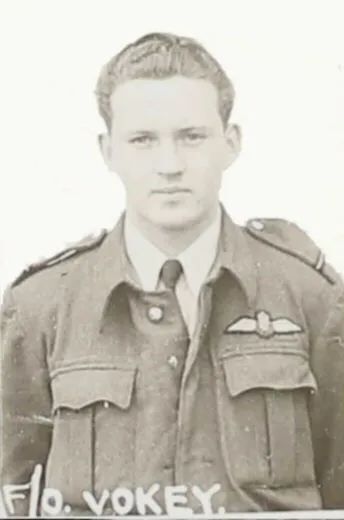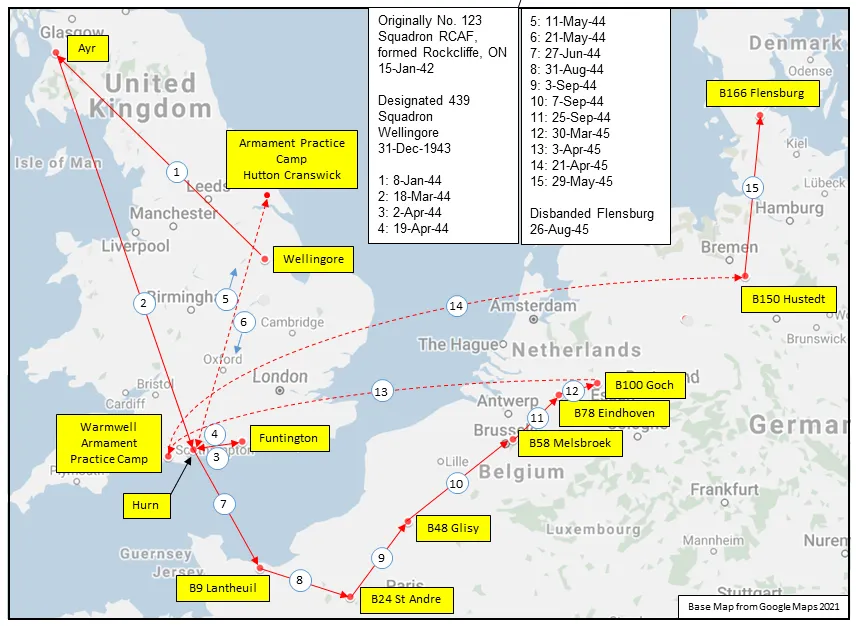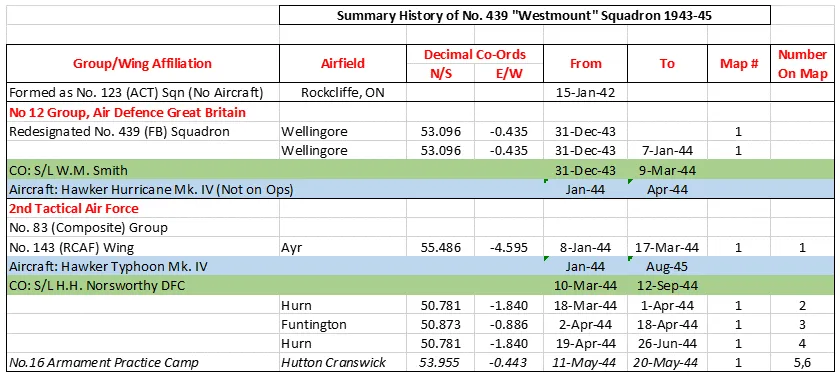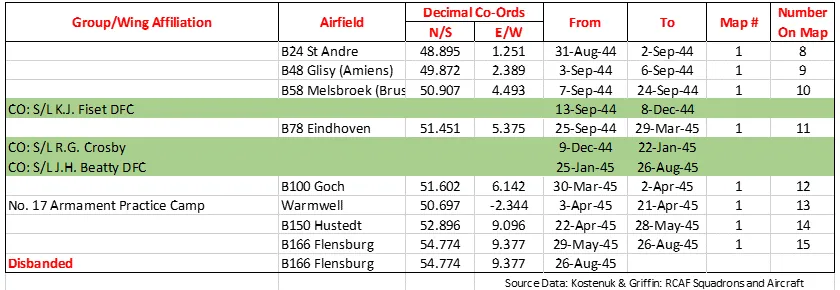Vokey, Richard Walter (Flying Officer)
Killed in Action 1944-September-24


Birth Date: 1923
Born:
Parents: Son of John Philip and Catherine Vokey, of Montreal, Province of Quebec.
Spouse:
Home: Montreal, Quebec
Enlistment:
Enlistment Date: unkown date
Service
RCAF
Unit
439 (FB) Sqn- Squadron
Fangs of Death
Base
B.48 Glisy, France
Rank
Flying Officer
Position
Pilot
Service Numbers
J/25397
Home
 Montreal, Quebec
Montreal, Quebec
Typhoon serial: PD465

Hawker Typhoon Mk. IB (Serial No. RB402), coded 5V-P, of No. 439 Squadron, RCAF, landing at airfield B100, Goch, Germany, ca. 1944
The Hawker Typhoon (Tiffy in RAF slang) is a British single-seat fighter-bomber, produced by Hawker Aircraft. It was intended to be a medium-high altitude interceptor, as a replacement for the Hawker Hurricane but several design problems were encountered and it never completely satisfied this requirement.
The Typhoon was originally designed to mount twelve .303 inch (7.7 mm) Browning machine guns and be powered by the latest 2,000 hp engines. Its service introduction in mid-1941 was plagued with problems and for several months the aircraft faced a doubtful future. When the Luftwaffe brought the formidable Focke-Wulf Fw 190 into service in 1941, the Typhoon was the only RAF fighter capable of catching it at low altitudes; as a result it secured a new role as a low-altitude interceptor.
The Typhoon became established in roles such as night-time intruder and long-range fighter. From late 1942 the Typhoon was equipped with bombs and from late 1943 RP-3 rockets were added to its armoury. With those weapons and its four 20mm Hispano autocannons, the Typhoon became one of the Second World War's most successful ground-attack aircraft.
By 1943, the RAF needed a ground attack fighter more than a "pure" fighter and the Typhoon was suited to the role (and less-suited to the pure fighter role than competing aircraft such as the Spitfire Mk IX). The powerful engine allowed the aircraft to carry a load of up to two 1,000 pounds (450 kg) bombs, equal to the light bombers of only a few years earlier. The bomb-equipped aircraft were nicknamed "Bombphoons" and entered service with No. 181 Squadron, formed in September 1942. Wikipedia
Unit Desciption
439 (FB) Sqn Fangs of Death ("Westmount")
History of the Squadron before and during World War II (Aircraft: Hurricane IV, Typhoon IB)

[ Note that during WWII the squadron did not have a badge nor a motto. These were awarded later.]
No 439 (F) Squadron was formed in Rockcliffe, Ontario  as No. 123 (Army Co-operation) Squadron RCAF Ontario, on Jan 15 1942. It was the second of six home squadrons transferred overseas without its aircraft, and was re-designated No. 439 (FB) Squadron RCAF at Wellingore, Lincolnshire, UK
as No. 123 (Army Co-operation) Squadron RCAF Ontario, on Jan 15 1942. It was the second of six home squadrons transferred overseas without its aircraft, and was re-designated No. 439 (FB) Squadron RCAF at Wellingore, Lincolnshire, UK  on December 31, 1943. It flew Typhoon aircraft in the preparation for D-Day and afterwards gave close support to the ground troops by dive-bombing and strafing enemy strongpoints, bridges, and road and rail traffic. They moved with the ground troops through France, the Low Countries, and Germany. The squadron was disbanded at Flensburg, Germany
on December 31, 1943. It flew Typhoon aircraft in the preparation for D-Day and afterwards gave close support to the ground troops by dive-bombing and strafing enemy strongpoints, bridges, and road and rail traffic. They moved with the ground troops through France, the Low Countries, and Germany. The squadron was disbanded at Flensburg, Germany  on August 26, 1945.
on August 26, 1945.
In the course of operations, the squadron flew 3996 sorties for the loss of 41 aircraft and 37 pilots, of whom 19 were killed, 9 missing, and 6 POWs. They dropped 2108 tons of bombs and accounted for a large number of rail and road vehicles. The squadron amassed 12 DFCs. Battle Honours were: Fortress Europe 1944, France and Germany 1944-45, Normandy 1944, Rhine.Wikipedia, Kostenuk and Griffin
Maps for Movements of 439 Squadron 1943-45

MAP 1: 439 Squadron Movements 1943-45 (right-click on image to display enlarged in new tab)
|
439 Squadron History Summary 1943-45

439 Squadron History Summary 1943-45

History of the Squadron Post-WWII (Aircraft: Sabre 2, 5, 6, Starfighter, Hornet, Griffon)

The squadron was re-formed as a Fighter unit at Uplands (Ottawa), Ontario  on 1 September 1951 equipped with Canadair Sabre aircraft. The squadron joined No. 1 (Fighter) Wing at North Luffenham, Nottinghamshire, England
on 1 September 1951 equipped with Canadair Sabre aircraft. The squadron joined No. 1 (Fighter) Wing at North Luffenham, Nottinghamshire, England  in June 1952. In doing so, it initiated the first of four Operations “Leapfrog†– mass transatlantic flights by Sabre-equipped units to No. 1 Air Division Europe. Despite bad weather throughout the move, the 21 aircraft made the 3560-mile trip without mishap, to complete the formation of No. 1 Wing. Early in 1955, the unit moved with the wing to its French base at Marville
in June 1952. In doing so, it initiated the first of four Operations “Leapfrog†– mass transatlantic flights by Sabre-equipped units to No. 1 Air Division Europe. Despite bad weather throughout the move, the 21 aircraft made the 3560-mile trip without mishap, to complete the formation of No. 1 Wing. Early in 1955, the unit moved with the wing to its French base at Marville  . Selected as one of eight squadrons of No. 1 Air Division Europe to be re-equipped with CF-104 Starfighter aircraft, it was deactivated on 1 November 1963 and reactivated as Strike Reconnaissance on 2 March 1964. They moved with 3 Wing to Lahr, Germany
. Selected as one of eight squadrons of No. 1 Air Division Europe to be re-equipped with CF-104 Starfighter aircraft, it was deactivated on 1 November 1963 and reactivated as Strike Reconnaissance on 2 March 1964. They moved with 3 Wing to Lahr, Germany  on April 1, 1967, then to CFB Baden-Soellingen, Germany
on April 1, 1967, then to CFB Baden-Soellingen, Germany  in 1971 as 439 Tactical Fighter Squadron. The squadron disbanded in November 1984 and reformed in November 1985 with the CF-18. During the Gulf War, the squadron fought as part of the Coalition of the Gulf War. They were disbanded at Baden-Soellingen on May 15, 1993 and reactivated shortly after at 3 Wing Bagotville, Quebec
in 1971 as 439 Tactical Fighter Squadron. The squadron disbanded in November 1984 and reformed in November 1985 with the CF-18. During the Gulf War, the squadron fought as part of the Coalition of the Gulf War. They were disbanded at Baden-Soellingen on May 15, 1993 and reactivated shortly after at 3 Wing Bagotville, Quebec  as 439 Combat Support Squadron.
as 439 Combat Support Squadron.
The role of a Combat Support Squadron is to provide an immediate response to aircraft emergencies for operational squadrons flying out of 3 Wing Bagotville. As a secondary role, the Squadron can be called on to augment Search and Rescue operations in the region, tasked by the Joint Regional Co-ordination Centre. The squadron’s crews train continually in order to ensure an extremely high level of proficiency and this often means training with outside agencies like the Canadian Coast Guard, CASERA/SERABEC or local police. The squadron is only able to reach this level of proficiency thanks to the tireless support of its maintenance personnel who are dedicated to keeping the CH-146 flying. 439 combat support squadron’s crews, maintainers and aircraft are also often tasked with supporting Operation LENTUS in the event of domestic natural disasters necessitating the Canadian Armed Forces’ assistance.
 Canadian Virtual War Memorial
Canadian Virtual War Memorial Wikipedia Hawker Typhoon
Wikipedia Hawker Typhoon Harold A.Skaarup Web Page
Harold A.Skaarup Web Page YouTube Hawker Typhoon in action
YouTube Hawker Typhoon in action